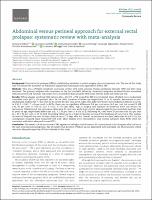| dc.contributor | Vall d'Hebron Barcelona Hospital Campus |
| dc.contributor.author | Fuschillo, Giacomo |
| dc.contributor.author | Simillis, Constantinos |
| dc.contributor.author | Selvaggi, Lucio |
| dc.contributor.author | Signoriello, Giuseppe |
| dc.contributor.author | Vinci, Danilo |
| dc.contributor.author | Pellino, Gianluca |
| dc.date.accessioned | 2022-08-18T11:22:39Z |
| dc.date.available | 2022-08-18T11:22:39Z |
| dc.date.issued | 2022-04 |
| dc.identifier.citation | Pellino G, Fuschillo G, Simillis C, Selvaggi L, Signoriello G, Vinci D, et al. Abdominal versus perineal approach for external rectal prolapse: systematic review with meta-analysis. BJS Open. 2022 Apr;6(2):zrac018. |
| dc.identifier.issn | 2474-9842 |
| dc.identifier.uri | https://hdl.handle.net/11351/8018 |
| dc.description | External rectal prolapse; Surgery |
| dc.description.abstract | Background
External rectal prolapse (ERP) is a debilitating condition in which surgery plays an important role. The aim of this study was to evaluate the outcomes of abdominal approaches (AA) and perineal approaches (PA) to ERP.
Methods
This was a PRISMA-compliant systematic review with meta-analysis. Studies published between 1990 and 2021 were retrieved. The primary endpoint was recurrence at the last available follow-up. Secondary endpoints included factors associated with recurrence and function. All studies were assessed for bias using the Newcastle–Ottawa Scale and Cochrane tool.
Results
Fifteen studies involving 1611 patients (AA = 817; PA = 794) treated for ERP were included, three of which were randomized controlled trials (RCTs; 114 patients (AA = 54; PA = 60)). Duration of follow-up ranged from 12 to 82 months. Recurrence in non-randomized studies was 7.7 per cent in AA versus 20.1 per cent in PA (odds ratio (OR) 0.29, 95 per cent confidence interval (c.i.) 0.17 to 0.50; P < 0.001, I2 = 45 per cent). In RCTs, there was no significant difference (9.8 per cent versus 16.3 per cent, AA versus PA (OR 0.82, 95 per cent c.i. 0.29 to 2.37; P = 0.72, I2 = 0.0 per cent)). Age at surgery and duration of follow-up were risk factors for recurrence. Following AA, the recurrence rates were 10.1 per cent and 6.2 per cent in patients aged 65 years and older and less than 65 years of age, respectively (effect size [e.s.] 7.7, 95 per cent c.i. 4.5 to 11.5). Following PA, rates were 27 per cent and 16.3 per cent (e.s. 20.1, 95 per cent c.i. 13 to 28.2). Extending follow-up to at least 40 months increased the likelihood of recurrence. The median duration of hospital stay was 4.9 days after PA versus 7.2 days after AA. Overall, incontinence was less likely after AA (OR 0.32), but constipation occurred more frequently (OR 1.68). Most studies were retrospective, and several outcomes from RCTs were not consistent with those observed in non-RCTs.
Conclusion
The overall risk of recurrence of ERP appears to be higher with PA versus AA. Incontinence is less frequent after AA but at the cost of increased constipation. Age at surgery and duration of follow-up are associated with increased risk of recurrence, which warrants adequate reporting of future studies on this topic. |
| dc.language.iso | eng |
| dc.publisher | Oxford University Press |
| dc.relation.ispartofseries | BJS Open;6(2) |
| dc.rights | Attribution 4.0 International |
| dc.rights.uri | http://creativecommons.org/licenses/by/4.0/ |
| dc.source | Scientia |
| dc.subject | Recte - Malalties - Cirurgia |
| dc.subject.mesh | Rectal Prolapse |
| dc.subject.mesh | /surgery |
| dc.title | Abdominal versus perineal approach for external rectal prolapse: systematic review with meta-analysis |
| dc.type | info:eu-repo/semantics/article |
| dc.identifier.doi | 10.1093/bjsopen/zrac018 |
| dc.subject.decs | prolapso rectal |
| dc.subject.decs | /cirugía |
| dc.relation.publishversion | https://doi.org/10.1093/bjsopen/zrac018 |
| dc.type.version | info:eu-repo/semantics/publishedVersion |
| dc.audience | Professionals |
| dc.contributor.organismes | Institut Català de la Salut |
| dc.contributor.authoraffiliation | [Pellino G] Colorectal Surgery, Department of Advanced Medical and Surgical Sciences, Università degli Studi della Campania ‘Luigi Vanvitelli’, Naples, Italy. Unitat de Cirurgia de Còlon i Recte, Vall d’Hebron Hospital Universitari, Barcelona, Spain. [Fuschillo G, Selvaggi L, Vinci D] Colorectal Surgery, Department of Advanced Medical and Surgical Sciences, Università degli Studi della Campania ‘Luigi Vanvitelli’, Naples, Italy. [Simillis C] Cambridge Colorectal Unit, Addenbrookes Hospital, Cambridge University Hospitals NHS Foundation Trust, Cambridge, UK. [Signoriello G] Section of Statistic, Department of Experimental Medicine, Università degli Studi della Campania ‘Luigi Vanvitelli’, Naples, Italy |
| dc.identifier.pmid | 35390136 |
| dc.identifier.wos | 000779084900003 |
| dc.rights.accessrights | info:eu-repo/semantics/openAccess |

